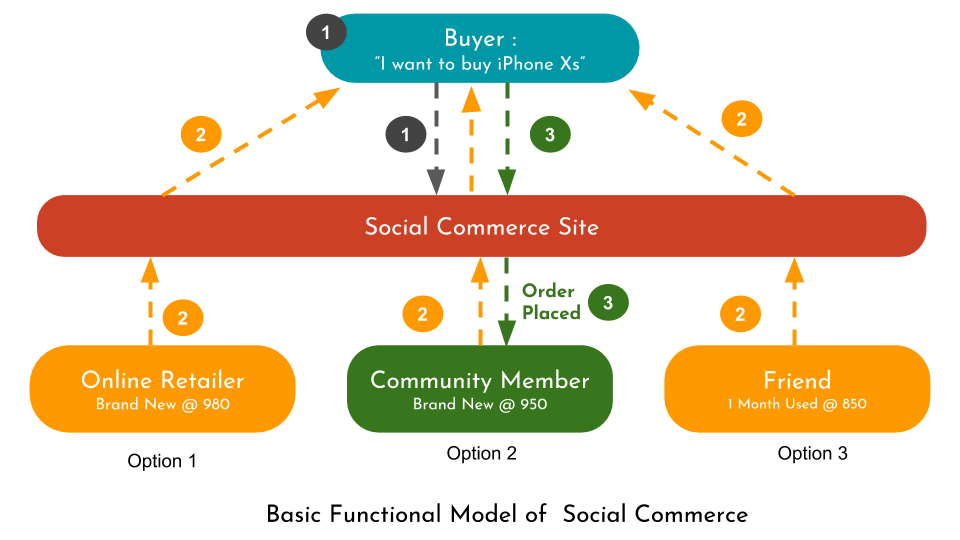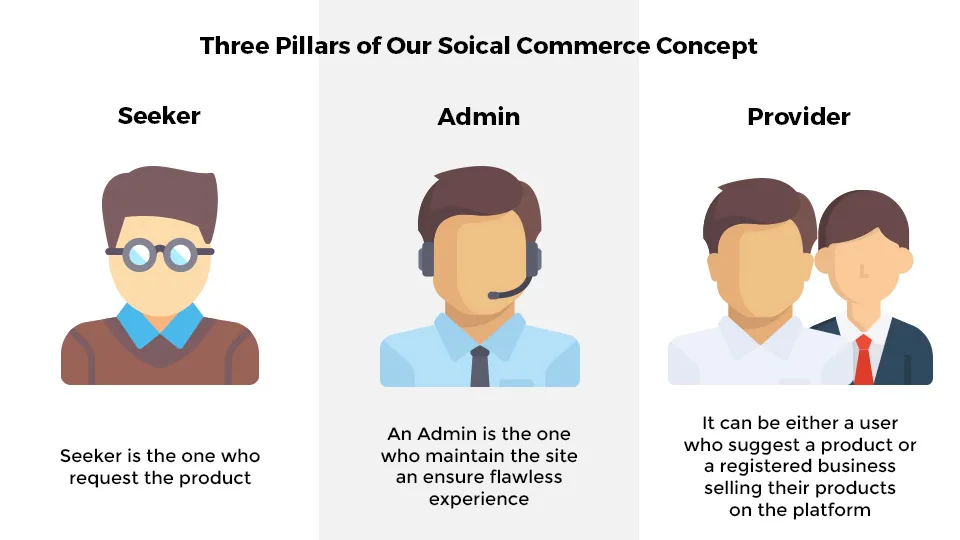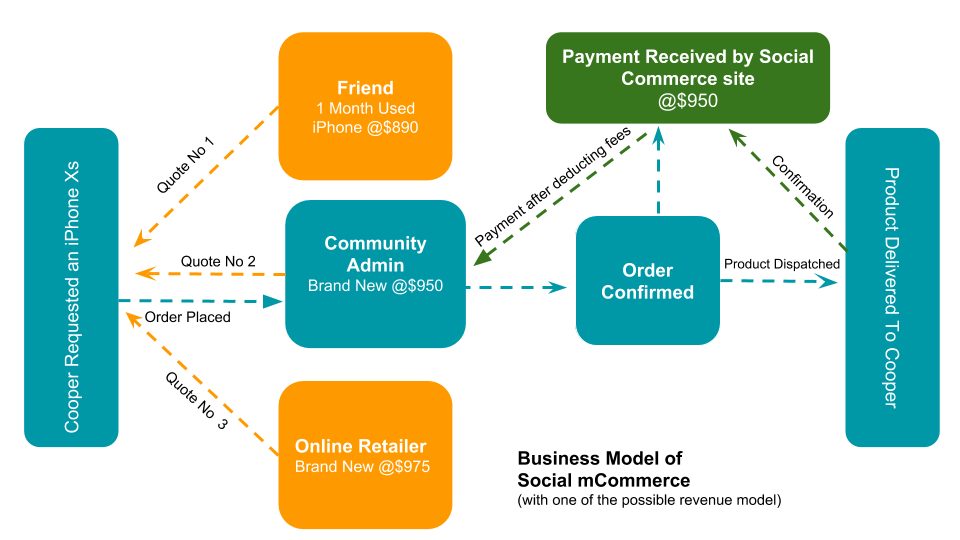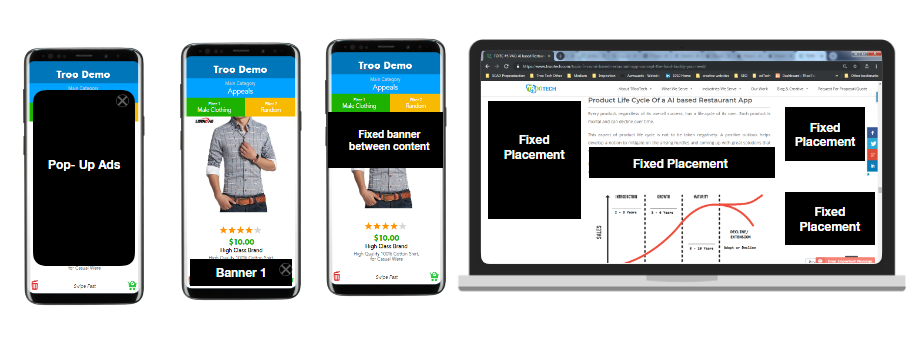Topic #1 VAC: Social Commerce Concept & A Disruptive Human to Human Business Model

When planning to step into the world of business, the first and foremost aspect any individual concentrates upon is an indifferent idea to radically drive that particular industry. Same is the case with this exclusive Social Commerce concept which we call seCommerce, which calls the business personas for its trendsetting development and implementation.
So what’s the hack about this Social Commerce Concept?
Social Commerce is an intersection between eCommerce and Social Media on mobile platforms.
It is a kind of social network that encourages social engagement so that users are drawn towards an online purchase of products and services.
Thus, it helps the users to get advises and suggestions about the product from their trusted individuals.
Next, they are redirected to the eCommerce Portal Links / Meta information about the product, and ultimately they make purchases.
How Exactly this Social Commerce Concept Will Work?
Commemorating the latest trends of Social Networks and Online Marketplaces on an individual basis, Our seCommerce has the potential to bring about a disruptive change in the digital market store.
It is like a Social Networking Site, where a user has a Profile, Followers and Following, Different Community for different topics however the platform is not a social networking site, it is a dedicated site for online commerce.
Hence it has robust feature for buying or selling goods online.
The business model of this social commerce concept is based on a simple, three-step mechanism
Step 1: Putting a Request;
When a seeker (user) wants any product he will simply put a request for the product, there are a predefined set of product categories, which helps the app to simplify and organize the request from the seeker.
Apart from categories there are set of predefined additional requests which he/she can make, for example, if a seeker wants a formal shirt, he/she will be able to choose, size, color, material or brand etc. and there is also an additional box to mention any other request apart from these predefined ones.
Step 2: Quoting Offer;
Once the seeker submits his/her request, a notification will be sent to all the relevant person, his followers, relevant community/groups, the Online retailers selling the product.
Then the one who has a product or wants to sell the product will quote the offer with product image and attributes, even if someone wants to suggest a seller he can do that as well, the seeker will get a notification for every quote submitted by the provider.
Step 3: Placing Order;
Once the user gets all the quotes from friends, followers, online sellers, community members, he can choose any offer he wants and place the order with just click of a button.

Next steps in the process depend on the revenue model chosen for this concept, there are many revenue models to choose which are mentioned in the following parts of the blog.
This Social Commerce Concept is a unique yet very simple and adaptable business model, you can even adopt the model for selling services.
In the model business could have a unique business account where they get additional features like giving deals and offers, sponsored placement and more while the user gets multiple options and deals to choose from, the marketing managers can down-rightly market about their business, and the admin earns profit out of the customer satisfaction, so it is a win-win situation for everyone.
Features List We Would Plan For This Social Commerce Concept

For making the app based on our concept we have to make features for
- Seekers (Buyers or Consumers): They are the one who will make the community of users which will determine the success of the app
- Administrator; They are responsible for defining the product categories on the platform and listing the products as in every eCommerce
- Providers (Individual Users/Registered Businesses): Provider could be an individual user who suggests or sell his/her personal product like in C2C, they will get a basic set of features, and then there is a business account for online sellers.
- Registered Business Account: Business account will get advanced features for marketing and promoting the product and ultimately increasing sales.
General Account Features
General Features Needed in the App
________________
- Login And Registration; It is a must needed feature for any Social Media or eCommerce app, a user has to create an account for using the app for the first time, registering via Google or Facebook can be enabled, additionally, it could have the option to stay login on a particular device.
- Public Profile: It is an integral part of this social commerce concept, every user will have a profile like other social networking sites, but they can choose which information should be public and what should remain private.
- Follow Other Profiles: When an app has a public profile, then a feature of letting it follow is a no-brainer, once a user follows other users he/she will get updates about the activities of the people he/she is following.
- Create/Join a Community/Group: The Users can either create or join a community of their interest, so the members sharing the same interest can share their views, news or updates and even deals related to the product of common interest on one place.
- View Feeds & Notification: The user will get feeds and notification from updates from the community and following peoples or deals form any sellers.
The Features a Seeker (Buyer) requires
________________
- Selecting Product Categories: The user can select the product categories in which he/she is interested so that the app can recommend different deals and product to him/her.
- Adding Request: This is the most important or the core feature of this concept, users can request for any product they want with a click of the button.
- Additional Parameters: They are a set of predefined additional requirements a user might need in a product like for shirt there are predefined parameters like size, color, material etc.
- Additional Requirement Box; It will not be possible to define all the features for all the product, so for any additional requirements, there will be a text box for the users where they can mention their additional request.
- Order Tracking: A live order tracking option is very common these days after placing an order a seeker might need to know the progress of the order or see live shipment tracking, this information should be available to them 24×7 via the app.
Features For Provider (Basic)
________________
- Listing Product: The users as “providers” can list their product on their profile, like in a C2C platform and it will be automatically shared with the different communities or groups.
- Selecting Business Categories; The providers need to select the categories of product they are interested in selling or suggesting.
- Notification Alerts: Whenever there is a request from a seeker relevant to the earlier selected categories, a notification alert is sent to the provider which they can either ignore or fill the quote on the spot.
- Quote Form; When a provider accepts the request to quote, he will be presented with a dynamic and straightforward quote from where most of the parameters are predefined just like the seeker’s request form.
Admin Modules
- Manage User and Business Profile: Verify the account and the activities in the account, delete a post if found breaking the site rules or even permanently suspend the profile.
- Manage Product Categories and Product Listing: It is one of the most crucial tasks to continuously organize and improve categories of the product and add new product listing, for flawless user experience.
- Moderate Communities/Groups: The team of moderators will moderate the community and topics discussed in there so that a user can get reliable information, the app will have a dashboard from where the moderators can efficiently manage the activity.
Manage Subscription Plans: Manage the pricing according to the time period of the subscription plans and deciding the number of subscription plans for the vendor group
Manage Payments and Invoices: To look over the payments of subscription plans, relevant invoices generated automatically by the app system.
Manage Buying Requests: Admin holds the control over the buying requests as well which gets posted by the customer users
Advanced Business Account Features
Apart from general provider features mentioned above the business Account can have the following Advance features;
- Business Profile: Every registered user will have a verified business profile, which will have an additional option like user reviews and ratings, advertising options.
- Brand Page: Business having multiple brands can create an individual brand page where they can list the products, deals, discounts and more.
- One tap Contact Feature: The seekers can contact the business in one tap, via phone or email whichever suit the business.
- Analytics: The analytics help business to know how many people are visiting a product or brand page, and strategize different moves based on that.
Social Commerce Concept can be adopted by following niche
Fashion Industry
Apparels, Accessories, Footwear.
Consumer Electronics
AC, Television, Computer, Mobile Phones, Refregitor, etc.
Food and Grocery
Bakery Product, Vegetable, Fruits, FMCG products, etc.
Beauty and Wellness
Personal care products, premium beauty products, salon products, male beauty products etc.
Sports
Sports equipments, Gym accessories, training modules can also be added to it
Automobile Industry
New or secondhand Two-wheeler, four-wheeler, heavy vehicles and spare parts makes a great niche for the model
This is how you can generate Revenue from Social Commerce Business Model
This Social Commerce Concept Unlocks number of ways of generating revenue, any startup developing a social commerce marketplace can adopt any one or multiple options to create a revenue model for their site;
Transaction Fees:
________________
Transaction fees (aka. Commission, Service Charge) is the most adopted revenue model by an eCommerce marketplace.
It is simple and very viable, the marketplace charges a certain percentage of commission or transaction fees on the sale of the product via the site.
How will it work on this social commerce concept? (briefly)
let’s continue with the above example, (Assume that the transaction fee of social commerce site is 3% for this product)
Cooper (seeker) request for iPhone Xs, he receives 3 Quotes one form Retailer, one form Community Member, and One form his Friend.
Cooper choose Community member, he then gives the order to community member and makes payment of $950.
The payment will be received by Social Commerce site, and the site will notify the community member to deliver the phone to Cooper.
Once the phone is delivered to cooper, the Social Commerce site will pay $920 ($950 – 3% transaction fees) to Community Member.

Technical Challange in Adopting this model in the social commerce concept
The transaction fee is undoubtedly the best revenue model for a marketplace, and you can seamlessly integrate with the internal listing and product sell be business account holders, but the real challenge is to How to integrate the model if anyone suggests an outbound link for the product?
Advertisement Model
________________
There are two advertising models which can be adopted for this social commerce business model
- Display Ads
- Sponsored Response.
Display Ads

Display ads are fixed banners showing images, gifs, videos or text appear on the website or mobile apps.
It is just like a billboard on the road but has more targeting options, remarketing, interest, demographic, geographic targeting.
Sponsored Response
It could be an excellent tool for the business account holder on this platform when a seeker is posting a request the site will automatically show the ‘sponsored product’ matching the request of the seeker.
By this way, the buyer who wanted the product urgently and does not want to wait for the quotation has an instant option to choose.
Business Account
For this model charging for the business model makes really good scenes, there are three ways how you can adopt the business model.
- One Time Membership Fees: Businesses are charged a one-time membership for creating a business profile.
- Subscription Fees: A fixed yearly/quarterly/monthly subscription fees are charged to create a business profile, after which they can access all the benefits associated with it until the expiry of the subscription.
- Freemium Account: The business can create a business profile for free, but are additionally charged for accessing each of the premium features.
Follow Us On

